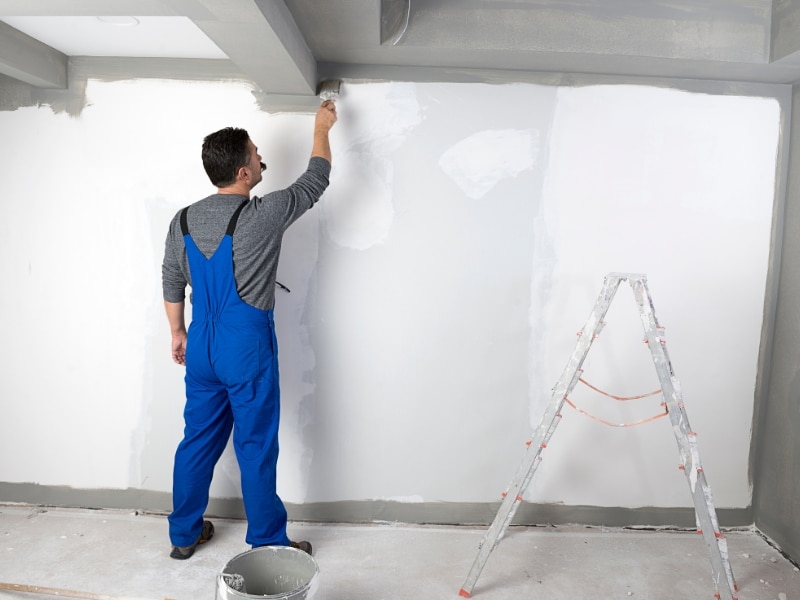Big paint jobs on commercial buildings are never straightforward. Between tricky surfaces, strict timelines, and safety requirements, it’s no walk in the park. So, how do commercial property painters manage to complete large-scale projects without throwing a spanner in the works? The answer lies in preparation, experience, and systems that handle every detail, down to the last brushstroke. This article examines the key challenges, solutions, and expectations associated with large commercial painting projects, enabling you to understand what goes into achieving a top-notch result.
What large-scale issues do commercial property painters resolve?
Big commercial jobs mean bigger headaches—but the right team knows how to fix them before paint even hits the wall.
- Surface degradation: Cracked render, flaking paint and water ingress can all cause adhesion issues if not repaired first. Skilled painters will dig deeper to identify whether the cause stems from waterproofing failure or structural wear.
- Previous coating failures: Incompatible or incorrectly applied older coatings can blister or peel when applied over new ones. Removal and reapplication require detailed inspection of coating history and compatibility testing.
- Substrate inconsistency: Surfaces such as metal, concrete, and timber each require tailored preparation and coating approaches. Each material reacts differently to primers and topcoats, especially under the extreme conditions of the Australian climate.
- Structural movement: Shifts in large buildings can open joints or create stress cracks that must be filled and stabilised. A flexible sealant or joint compound is often necessary to maintain long-term integrity.
Each of these issues can ruin a paint job if ignored. That’s why qualified painters for large commercial properties focus heavily on assessment and prep from day one.
How do delays affect major commercial painting projects?
Time is money, and downtime in commercial buildings doesn’t come cheap. Even short delays can snowball into costly disruptions.
- Business interruptions: Commercial tenants may lose access to entryways, lobbies, or loading docks, which can cause delays in operations. Extended closures could also violate lease agreements or strain relationships with tenants.
- Workplace scheduling clashes: Multiple trades on-site or staff presence can interfere with painter access and timelines. This often requires split-shift coordination or nighttime scheduling to minimise disruption.
- Weather disruptions: Wind, rain, or humidity can delay drying times or necessitate the rescheduling of outdoor work. Accurate weather tracking tools and flexible plans are crucial in these cases.
- Permit and inspection hold-ups: Government or strata approvals might not arrive when expected, causing unplanned pauses. Navigating red tape efficiently often comes down to experience and local knowledge.
Delays don’t just frustrate—they compound costs. Efficient painters plan staging, access, and sequencing early to minimise downtime and complete projects on schedule.
Are untrained commercial painters a risk for business sites?
The short answer: absolutely. A lack of training isn’t just about poor painting—it can affect your entire site.
- Improper safety practices: Without correct training, workers might skip harnesses, ignore exclusion zones, or mishandle scaffolding. This exposes clients to serious legal and insurance risks.
- Material misapplication: Choosing the wrong coating, using the wrong roller or over-thinning paint compromises finish and longevity. It can also void product warranties if misapplied.
- Lack of surface knowledge: Untrained painters may overlook key substrate issues, such as moisture ingress or rust bleed-through, which can compromise the integrity of the finished product. These oversights often become visible weeks after completion.
- Cleanup and waste mishandling: Overspray, spilled solvents, and poor cleanup can damage property and breach regulations. An uncontained mess also creates hazards for workers and site users.
Untrained labour is cheap upfront, but it costs more in the long term. Competent crews handle it properly, ensuring both safety and optimal results. They also handle prep techniques that support solutions for cracking paint in commercial buildings without guesswork.
What makes site prep crucial for commercial painters?

Prep work often takes longer than the painting itself, and there’s a reason for that—good prep makes everything else possible.
- High-pressure washing: Removes grime, grease and contaminants from brick, concrete and metal, ensuring clean surfaces. Skipping this step risks adhesion issues that show up as early failure.
- Sanding and patching: Smooths out old surfaces, fills holes, and restores surfaces to an even plane. For textured or historic surfaces, this must be done with precision to avoid damage.
- Masking and taping: Shields non-painted areas like windows, hardware and signage from overspray or accidental marks. This creates crisp lines and avoids unnecessary touch-up work.
- Priming and sealing: Tailors surface porosity, strengthens adhesion, and extends the lifespan of top coats. Different primers are selected for rust resistance, alkaline walls or porous concrete.
Preparation isn’t optional—it’s the baseline for quality. It’s also when pros assess surfaces and select materials, including choosing the right paint for your commercial property based on sun exposure, weather and traffic.
What equipment and coatings do commercial painting contractors use?
You can’t tackle a multi-storey job with a tin and ladder. Scalable systems and specialty coatings are the backbone of commercial work.
- Airless spray machines: Deliver high-speed, even coverage across large areas like warehouses and retail ceilings. This method reduces overspray and improves project efficiency.
- Scaffolding and boom lifts: Provide stable, safe access to heights and hard-to-reach façades or overhead surfaces. This allows full coverage without compromising safety or speed.
- Anti-graffiti coatings: Used in public or high-traffic areas to resist tagging and ease cleaning. These coatings form an invisible layer that allows graffiti to be wiped off.
- Industrial-grade epoxies and membranes: Withstand chemicals, moisture and abrasion in factories, kitchens or plant rooms. They also resist UV exposure and don’t yellow over time.
Here’s a quick summary of coating types and their purposes:
| Coating Type | Key Features | Ideal Use Cases |
| Epoxy Coating | Durable, chemical-resistant | Warehouses, mechanical rooms |
| Acrylic Paint | UV stable, easy to clean | Offices, schools, and medical buildings |
| Polyurethane Finish | Scratch-resistant, high-gloss finish | Retail spaces, corridors, and common areas |
| Anti-Graffiti Layer | Protective barrier, easy to clean | External walls, car parks, street fronts |
These materials aren’t selected by guesswork—they align with traffic levels, moisture load and asset longevity.
Which safety rules apply to commercial property painters on-site?
Site safety isn’t flexible—it’s mandatory, and professional painters plan every move around it.
- Fall prevention systems, including guardrails, harnesses, and roof access systems, control height-related risks. This includes anchor point testing and ladder inspections.
- Safe chemical handling: Complies with SDS and labelling rules, especially when using solvent-based or flammable materials. Storage and ventilation are equally critical.
- Work zone exclusion: Signs, barriers and timing schedules limit tenant and public exposure to hazards. Access control also prevents property damage and liability issues.
- Daily job safety analysis (JSA): On-site hazard reviews keep risks in check and ensure compliance with Safe Work standards. Every worker signs off before starting the shift.
Maintaining a clean, safe job site also ties into broader maintenance responsibilities for commercial property owners, particularly when shared areas are involved.
Final thoughts
Large-scale commercial painting involves far more than wall colour—it’s about coordination, compliance and execution. From recognising repair needs to adjusting access, commercial property painters make complex work appear seamless. They handle substrate fixes, safety plans and product selection to deliver results that last. For those wanting a closer look at how professional crews work across Sydney’s larger buildings, see what Sydney Paintmasters does differently for large properties.

